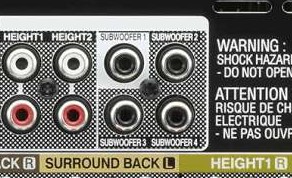Four Subwoofers? Denon Marantz “Directional” Subwoofer Mode – What is the Correct Setting for Best Bass?
Recently Denon and Marantz released their 2022 AV receiver models. One of the more surprising announcements was that the new Denon and Marantz models supported four subwoofers. That’s a lot! While we agree that if you are going to support more than two subwoofers, four is the next logical number, how exactly does it work? Well, we’ve done a little research and found that they have both “standard” and “directional” subwoofer modes. But what are they and what setting should you use?
Why Four Subwoofers?
We’ve covered how four subwoofers can benefit your room. In short, in the right room, it can make your bass more uniform for all the seats. But Marantz and Denon didn’t stop at just four subwoofer outputs. They’ve given you options.
First, and most importantly, they’ve allowed you to designate one (subwoofer four output) as a “tactile transducer” output. For those that read our article on how to connect a tactile transducer to your system, you know that it isn’t as easy as just adding a cable. The tactile transducer output sends out a signal meant specifically for your bass shakers. It has suddenly become a lot easier to add bass shakers to your system!
Second, you don’t have to add four subwoofers to your Marantz or Denon-powered home theater. You can add any number up to four but there are two settings – Standard and Directional.
Standard Setting
The standard setting is the default and fairly straightforward. With the standard setting, your Denon and Marantz receiver will treat your four subwoofers as one. Each subwoofer will get the LFE channel plus any bass from speakers that are set to “small” in your settings (which should be all of them). Simple.
Directional Setting
The directional setting is a little more involved. At its heart, it leans on the idea that the bass that is played by your subwoofers should only be the bass that is from the speakers closest to it physically in the room. If you’ve seen pictures with subwoofers flanking front speakers (something that should rarely happen), the bass that is associated with each of those speakers should come from the sub closest to it.
To achieve this, Denon and Marantz must dictate where you place your four subwoofers. With the standard setting, they just need to be in the same room. With directional, you need to follow the manual so that you place each subwoofer where Denon and Marantz dictate. If you have four subwoofers, Denon and Marantz say that they should be in the front left (sub 1), front right (sub 2), rear left (sub 3), and rear right (sub 4). The three and two subwoofer options have similar restrictions. This is so the receiver can know which bass (from speakers set to small) should be sent to which subwoofers. The LFE? That goes to all four subwoofers.
Which Setting is Correct?
While directional might sound correct, any reader of this publication will know that it isn’t. Bass and your room are intrinsically linked. While the position of your speakers will dictate the direction from which you perceive the sound, this is not true of bass. Bass interacts with your room far before you can perceive it. This means that the position of your subwoofers within the space shouldn’t (and doesn’t) matter.
The correct setting (as we outlined here) is for each subwoofer to get the same signal. All the LFE and bass from small speakers should go to all the subwoofers (however many you have). Thus, set your Denon or Marantz for the standard subwoofer mode and forgo the directional option. Then follow our guide for setting up dual subwoofers.


